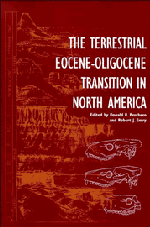Book contents
- Frontmatter
- Contents
- Contributors
- Preface
- PART I The Chronostratigraphy of the Uintan through Arikareean
- 1 Magnetic stratigraphy and biostratigraphy of the middle Eocene Uinta Formation, Uinta Basin, Utah
- 2 Biostratigraphy and magnetostratigraphy of the Bridgerian-Uintan Washakie Formation, Washakie Basin, Wyoming
- 3 Magnetic stratigraphy, sedimentology, and mammalian faunas of the early Uintan Washakie Formation, Sand Wash Basin, northwestern Colorado
- 4 Theoretical biochronology, the Bridgerian-Uintan boundary and the “Shoshonian Subage” of the Uintan
- 5 Middle Eocene mammalian faunas of San Diego County, California
- 6 Stratigraphy and paleomagnetism of the middle Eocene Friars Formation and Poway Group, southwestern San Diego County, California
- 7 Magnetostratigraphy of the upper middle Eocene Coldwater Sandstone, central Ventura County, California
- 8 Stratigraphy and paleomagnetism of the upper middle Eocene to lower Miocene (Uintan to Arikareean) Sespe Formation, Ventura County, California
- 9 Magnetostratigraphy of the Eocene-Oligocene transition in Trans-Pecos Texas
- 10 Magnetic stratigraphy of the Duchesnean part of the Galisteo Formation, New Mexico
- 11 Stratigraphy and vertebrate faunas of the Bridgerian-Duchesnean Clarno Formation, north-central Oregon
- 12 Eocene-Oligocene faunas of the Cypress Hills Formation, Saskatchewan
- 13 Magnetic stratigraphy of the White River Group in the High Plains
- 14 Magnetostratigraphy and biostratigraphy of the Eocene-Oligocene transition, southwestern Montana
- 15 The Whitneyan-Arikareean transition in the High Plains
- PART II Common Vertebrates of the White River Chronofauna
- Summary
- Index
11 - Stratigraphy and vertebrate faunas of the Bridgerian-Duchesnean Clarno Formation, north-central Oregon
Published online by Cambridge University Press: 06 July 2010
- Frontmatter
- Contents
- Contributors
- Preface
- PART I The Chronostratigraphy of the Uintan through Arikareean
- 1 Magnetic stratigraphy and biostratigraphy of the middle Eocene Uinta Formation, Uinta Basin, Utah
- 2 Biostratigraphy and magnetostratigraphy of the Bridgerian-Uintan Washakie Formation, Washakie Basin, Wyoming
- 3 Magnetic stratigraphy, sedimentology, and mammalian faunas of the early Uintan Washakie Formation, Sand Wash Basin, northwestern Colorado
- 4 Theoretical biochronology, the Bridgerian-Uintan boundary and the “Shoshonian Subage” of the Uintan
- 5 Middle Eocene mammalian faunas of San Diego County, California
- 6 Stratigraphy and paleomagnetism of the middle Eocene Friars Formation and Poway Group, southwestern San Diego County, California
- 7 Magnetostratigraphy of the upper middle Eocene Coldwater Sandstone, central Ventura County, California
- 8 Stratigraphy and paleomagnetism of the upper middle Eocene to lower Miocene (Uintan to Arikareean) Sespe Formation, Ventura County, California
- 9 Magnetostratigraphy of the Eocene-Oligocene transition in Trans-Pecos Texas
- 10 Magnetic stratigraphy of the Duchesnean part of the Galisteo Formation, New Mexico
- 11 Stratigraphy and vertebrate faunas of the Bridgerian-Duchesnean Clarno Formation, north-central Oregon
- 12 Eocene-Oligocene faunas of the Cypress Hills Formation, Saskatchewan
- 13 Magnetic stratigraphy of the White River Group in the High Plains
- 14 Magnetostratigraphy and biostratigraphy of the Eocene-Oligocene transition, southwestern Montana
- 15 The Whitneyan-Arikareean transition in the High Plains
- PART II Common Vertebrates of the White River Chronofauna
- Summary
- Index
Summary
ABSTRACT
Within its type area, the Clarno Formation (Eocene, north-central Oregon) includes Oregon's two oldest Tertiary terrestrial mammal localities, numerous fossil plant localities, and many radiometrically dated rock units. Detailed lithostratigraphic mapping has now clarified the complex geologic history and stratigraphic framework which relate these localities and dates to each other and to the geologic record of adjacent areas. Of the five allostratigraphic units recognized within the local Clarno section, the second oldest includes the Nut Beds locality with vertebrates characteristic of the Bridgerian land mammal “age,” and the youngest includes the Hancock Quarry locality, the source of a large assemblage of Duchesnean vertebrates. Fossil plants are also preserved in both of these localities and in the middle unit. Those dates which are consistent with the local superpositional sequence also accord with dates on biostratigraphically correlated faunal assemblages elsewhere in North America
The Nut Beds local fauna, preserved within a lacustrine delta complex, includes species of Patriofelis, Orohippus, Hyrachyus, and Telmatherium which indicate a late Bridgerian North American Land Mammal “Age” (NALMA). This accords with an 40Ar/39Ar date of 48.32 Ma, but not with other dates near 44 Ma. A remarkably diverse floral record documents a paratropical to tropical rain forest environment, but, at about 14 million years older than the presently recognized Eocene/Oligocene boundary, it provides little evidence bearing on the rate of climatic cooling near the end of the Eocene.
- Type
- Chapter
- Information
- The Terrestrial Eocene-Oligocene Transition in North America , pp. 206 - 239Publisher: Cambridge University PressPrint publication year: 1996
- 22
- Cited by



